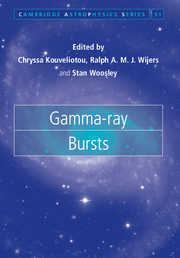Book contents
- Frontmatter
- Contents
- List of contributors
- Prologue
- 1 The discovery of the gamma-ray burst phenomenon
- 2 Instrumental principles
- 3 The BATSE era
- 4 The cosmological era
- 5 The Swift era
- 6 Discoveries enabled by multiwavelength afterglow observations of gamma-ray bursts
- 7 Prompt emission from gamma-ray bursts
- 8 Basic gamma-ray burst afterglows
- 9 The GRB–supernova connection
- 10 Models for gamma-ray burst progenitors and central engines
- 11 Jets and gamma-ray burst unification schemes
- 12 High-energy cosmic rays and neutrinos
- 13 Long gamma-ray burst host galaxies and their environments
- 14 Gamma-ray burst cosmology
- 15 Epilogue
- Indix
- Plate section
- References
13 - Long gamma-ray burst host galaxies and their environments
Published online by Cambridge University Press: 05 December 2012
- Frontmatter
- Contents
- List of contributors
- Prologue
- 1 The discovery of the gamma-ray burst phenomenon
- 2 Instrumental principles
- 3 The BATSE era
- 4 The cosmological era
- 5 The Swift era
- 6 Discoveries enabled by multiwavelength afterglow observations of gamma-ray bursts
- 7 Prompt emission from gamma-ray bursts
- 8 Basic gamma-ray burst afterglows
- 9 The GRB–supernova connection
- 10 Models for gamma-ray burst progenitors and central engines
- 11 Jets and gamma-ray burst unification schemes
- 12 High-energy cosmic rays and neutrinos
- 13 Long gamma-ray burst host galaxies and their environments
- 14 Gamma-ray burst cosmology
- 15 Epilogue
- Indix
- Plate section
- References
Summary
Introduction
Host galaxies have played an important role in determining the nature of gamma-ray burst (GRB) progenitors even before the first optical afterglows were detected. After the first detections of host galaxies, their properties provided strong evidence that long duration GRBs were associated with massive stellar deaths and hence the concept of using long-duration GRBs to probe the evolution of the cosmic star-formation rate was conceived.
In this chapter we first briefly discuss some basic observational issues related to what a GRB host galaxy is (whether they are operationally well defined as a class) and sample completeness. We then describe some of the early studies of GRB hosts, starting with statistical studies of upper limits done prior to the first detections, the first host detection after the BeppoSAX breakthrough, and leading up to the current Swift era. Finally, we discuss the status of efforts to construct a more complete sample of GRBs based on Swift and end with an outlook. We only consider the host galaxies of long-duration GRBs. For short GRBs we refer to Berger (2009). The study of GRB host galaxies has previously been reviewed by van Paradijs et al. (2000) and Djorgovski et al. (2003).
Early results based on GRB host galaxy studies
Pre-afterglow host galaxy studies
Prior to the first afterglow detections a few gamma-ray bursts with relatively small uncertainties on their derived position were studied based on the Interplanetary Network (IPN; Hurley et al. 1993, see also Chapter 2).
- Type
- Chapter
- Information
- Gamma-ray Bursts , pp. 269 - 290Publisher: Cambridge University PressPrint publication year: 2012
References
- 7
- Cited by



